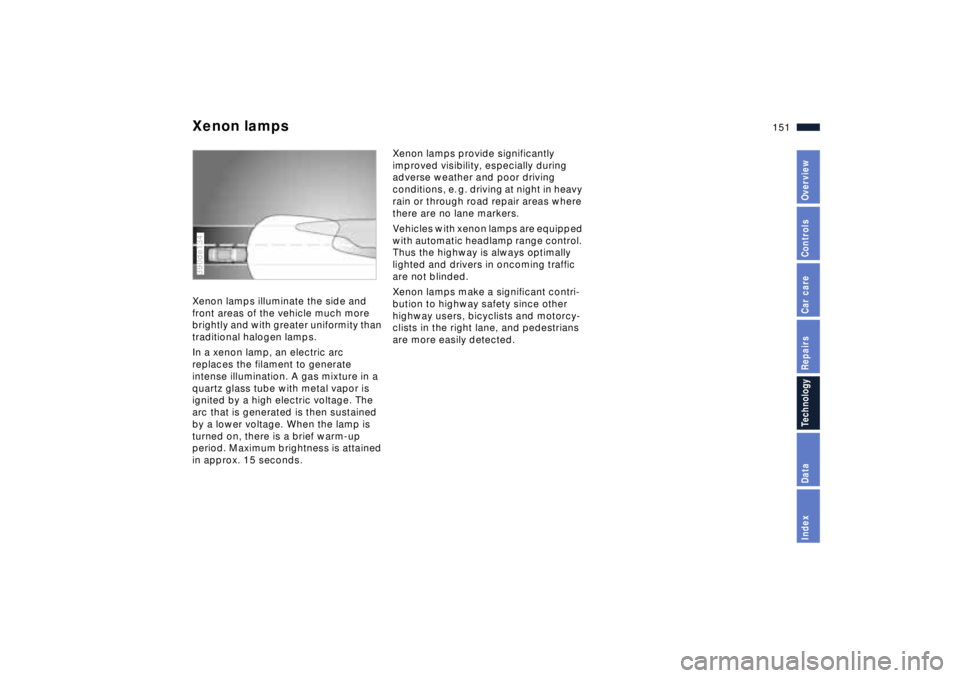2001 BMW Z8 air condition
[x] Cancel search: air conditionPage 93 of 170

93n
IndexDataTechnologyRepairsCar careControlsOverview
Winter operationDriving on low-traction road
surfacesDo not activate the Sport mode (refer to
page 66). Use smooth, gentle pressure
to control the accelerator pedal. Avoid
excessive engine speeds and upshift
early. Downshift well in advance when
approaching uphill or downhill
grades. Maintain an adequate distance
between yourself and the vehicle
ahead.BrakesWinter road conditions substantially
reduce the amount of traction available
between the tires and the road surface.
The resulting increases in braking
distance are considerable and should
be kept in mind at all times.
ABS is intended to prevent the wheels
from locking during brake applications,
thus helping to maintain vehicle stability
and steering response.If the ABS does not respond in a critical
braking situation and the wheels lock,
reduce the pressure on the brake pedal
until the wheels just start to roll again
while still maintaining enough force to
continue braking.
Then increase the pressure, reduce the
pressure when the wheels lock, reapply
pressure etc.
This staggered braking procedure will
reduce braking distances while helping
you maintain steering control.
You can always then attempt to steer
around hazards after you have reduced
pressure on the brake pedal.
Never downshift to exploit engine
braking when driving on slippery
road surfaces, as this could lead to a
loss of traction at the rear wheels,
impairing your ability to control the
vehicle.<
Depress the clutch during hard
braking on road surfaces that
provide only poor or uneven traction.<
Skid control Depress the clutch and release the
accelerator pedal. Countersteer care-
fully and attempt to regain control of the
vehicle.ParkingEngage first or reverse gear. Depending
on the steepness of the incline, you can
apply the parking brake as well. In order
to prevent the parking brake pads from
locking due to frost or corrosion, dry
them by gently applying the parking
brake as the vehicle is coming to a stop.
Make sure that following traffic is not
endangered.
The brake lamps do not come
on when the parking brake is
engaged.<
Page 99 of 170

99n
IndexDataTechnologyRepairsCar careControlsOverview
Avoid overloading the vehicle so
that the permitted load on the tires
is not exceeded. Overloading can lead
to overheating and increases the rate
at which damage develops inside the
tires. You could have a blowout as a
result.
Unusual vibrations encountered during
normal vehicle operation can indicate
tire failure or some other vehicle defect,
as can variations in normal vehicle
response, such as a pronounced
tendency to pull to the left or right.
Should this occur, respond by immedi-
ately reducing your speed. Proceed
carefully to the nearest BMW center or
professional tire center, or have the
vehicle towed in to have it and its tires
inspected.
Tire damage can endanger the lives of
both the vehicle occupants and other
road users.<
To maintain good handling and vehicle
response, use only tires of a single tread
configuration from a single manufac-
turer. BMW tests and approves wheel/
tire combinations. Refer to page 103.DOT Quality GradesTread wear
Traction AA A B C
Temperature A B C
All passenger vehicle tires
must conform to Federal Safety
Requirements in addition to these
grades.
when tested under controlled condi-
tions on a specified government test
course.
For example, a tire graded 150 would
wear one and one-half (1g) times as
well on the government course as a tire
graded 100. The relative performance
of tires depends upon the actual condi-
tions of their use, however, and may
depart significantly from the norm due
to variations in driving habits, service
practices and differences in road char-
acteristics and climate.
TractionThe traction grades, from highest to
lowest, are AA, A, B and C.
Those grades represent the tire's ability
to stop on wet pavement as measured
under controlled conditions on speci-
fied government test surfaces of
asphalt and concrete. A tire marked C
may have poor traction performance.
The traction grade assigned to
this tire is based on straight-
ahead braking traction tests, and does
not include acceleration, cornering,
aquaplaning, or peak traction charac-
teristics.<
Tire condition Tire replacement
Page 102 of 170

102n
Special features of winter tires Snow chains
*
Choosing the right tireFor winter road driving, BMW recom-
mends winter tires (M+S radial belt
tires). Although all-season M+S tires
provide better winter traction than stan-
dard summer tires with H, V, W and ZR
speed ratings, they generally fail to
provide the same levels of performance
as standard snow tires in winter driving.
In the interests of safe tracking and
steering response, install radial tires
made by the same manufacturer and
with the same tread configuration on all
four wheels if you elect to mount winter
tires.
Use only winter tires with emer-
gency driving characteristics as
there is no spare tire available if you get
a flat tire.
For further information, refer to
page 135.<
Do not exceed specified
maximum speeds
Never exceed the maximum speed
for which winter tires are rated.
Unprofessional attempts by laymen to
service tires can lead to damage and
accidents.
Have this work performed by skilled
professionals only. Your BMW center
will be glad to assist you with both their
expertise and the proper equipment for
your vehicle.<
Tire condition, tire pressureOnce the tread depth on winter tires is
less than 0.16 in (4 mm), they are no
longer suitable for winter road driving,
and in the interest of safety should be
replaced.
Comply with the specified tire inflation
pressures Ð and be sure to have the
wheel and tire assemblies balanced
every time you change the tires.
The use of narrow-link BMW snow
chains is permissible in pairs only on
the rear wheels with winter tires with
tire size 245/45 R 18 96 H. Comply with
all manufacturer's safety precautions
when mounting the chains.
Do not activate the RDW system
while using snow chains.
Malfunction warnings and undetected
losses in pressure are possible when
driving with snow chains.
For further information, refer to
page 67.<
Page 109 of 170

109n
IndexDataTechnologyRepairsCar careControlsOverview
Engine oilChecking the oil level 1 Park the vehicle on a level surface
2 Let the warmed-up engine idle for
about 15 seconds, then turn it off
3 Pull the dipstick out after about
1 minute and wipe it off with a clean
lint-free cloth, tissue, or similar
material
4 Carefully push the dipstick all the way
into the guide tube and pull it out
again
5 The oil level should be between the
two marks on the dipstick.
As with fuel economy, oil consumption
is directly influenced by your driving
style and vehicle operating conditions.520de089
The oil volume between the two marks
on the dipstick corresponds to approx.
1.1 US quarts (1 liter). Do not fill beyond
the upper mark on the dipstick. Excess
oil will damage the engine.520de091
Adding engine oil Wait until the level has dropped to just
above the lower mark before adding oil.
However, never let the oil drop below
the lower mark.
BMW engines are designed to
operate without oil additives; the
use of additives could lead to damage
in some cases. This also applies to the
manual transmission, differential and
the power steering system.<520de090
Page 114 of 170

114n
The BMW Maintenance System has
been designed as a reliable means of
ensuring that you enjoy optimal vehicle
safety and reliability with only minimum
effort and expense.
Please keep in mind that regular service
not only plays a vital role in ensuring
continued vehicle safety, but also plays
a significant role in maintaining your
car's resale value.
520us006
Service Interval DisplayOptimal maintenance intervals are
calculated by using advanced tech-
nology; these are then indicated in the
Service Interval Display. While conven-
tional systems rely on distance traveled
alone to determine when service is due,
the BMW Maintenance System has for
years considered the actual conditions
under which the vehicle operates,
because miles can be traveled in many
different ways:
From the maintenance point of view,
62,000 miles (100,000 km) accumulated
in short-distance urban driving are not
equivalent to the same distance
covered at moderate speeds in long-
distance highway travel.
The BMW Maintenance System, which
is based on operating conditions,
includes the Engine Oil Service and
Inspections I and II.
Determining the maintenance intervals
according to the actual loads on the
vehicle covers every kind of operating
situation. However, even those drivers
who put significantly less than
6,000 miles (10,000 km) on their
vehicles annually should have the
engine oil changed at least every two
years since oil deteriorates over time,
regardless of use.
Service Warranty Information
Booklet (US models)/Warranty
and Service Guide Booklet
(Canadian models)For additional information on mainte-
nance intervals and procedures, please
refer to the Service and Warranty
Information Booklet (US models) or the
Warranty and Service Guide Booklet
(Canadian models).
Have your BMW center perform
maintenance and repair work.
Your BMW center is always informed on
the latest maintenance work and repair
techniques and equipped with the
required special tools. In addition,
checking parts known from experience
to be subject to wear is a permanent part
of the maintenance specifications.
Be sure that all maintenance work is
confirmed in the Service and Warranty
Information Booklet (US models) or the
Warranty and Service Guide Booklet
(Canadian models). These entries are
your proof of regular vehicle mainte-
nance and the basis for warranty
claims.<
The BMW Maintenance System
Page 117 of 170

117n
IndexDataTechnologyRepairsCar careControlsOverview
Caring for your vehicle
To remove stains from the
convertible top, use only BMW-
approved cleaning agents. Do not use
spot removers, paint thinners, solvents,
gasoline or similar substances for
removing stains; these agents destroy
the rubber seals, which in turn leads to
leaks.
A full range of car-care products is
available from your BMW center.<
HardtopPlease observe and follow the instruc-
tions for caring for your vehicle starting
on page 115.
Exterior finish Your vehicle is protected by a multilayer
finish applied at the factory. Protection
against corrosion is provided by
cataphoretic immersion priming using
materials that have been specially
developed over many years of
sustained research.
Regular maintenance makes an impor-
tant contribution to maintaining the
safety and value of your vehicle.
Increasing awareness of the effects of
harmful environmental factors on
vehicle finishes have led paint and
vehicle manufacturers to initiate
programs designed to further improve
the durability of their finishes. Despite
this, environmental factors that occur
locally or regionally can have negative
effects on the finish of your vehicle.
These should guide you in determining
the frequency and extent of your efforts
to maintain the vehicle finish.Road dirt, tar spots, dead insects,
animal droppings (strong alkali effect)
and even tree secretions (resins and
pollen), all contain substances capable
of causing damage to the finish of your
vehicle if allowed to remain for an
extended period of time (such as stains,
bumps, scratches and separation of the
top coat).
In industrial areas, deposits of flue dust,
lime, oily soot, precipitation containing
sulfur-dioxide (acid rain) and other envi-
ronmental pollutants will damage the
vehicle's finish unless adequate care is
provided Ð even though this is generally
limited to the outside horizontal
surfaces.
In tropical climates intense ultraviolet
radiation and high atmospheric
humidity are accompanied by tempera-
tures that can exceed 105 7 (40 6) in
the shade. Under those conditions, light
paints can reach temperatures of up
to 175 7 (80 6) while darker finishes
can heat to levels as high as 250 7
(120 6).
Page 151 of 170

151n
IndexDataTechnologyRepairsCar careControlsOverview
Xenon lamps Xenon lamps illuminate the side and
front areas of the vehicle much more
brightly and with greater uniformity than
traditional halogen lamps.
In a xenon lamp, an electric arc
replaces the filament to generate
intense illumination. A gas mixture in a
quartz glass tube with metal vapor is
ignited by a high electric voltage. The
arc that is generated is then sustained
by a lower voltage. When the lamp is
turned on, there is a brief warm-up
period. Maximum brightness is attained
in approx. 15 seconds.390de134
Xenon lamps provide significantly
improved visibility, especially during
adverse weather and poor driving
conditions, e. g. driving at night in heavy
rain or through road repair areas where
there are no lane markers.
Vehicles with xenon lamps are equipped
with automatic headlamp range control.
Thus the highway is always optimally
lighted and drivers in oncoming traffic
are not blinded.
Xenon lamps make a significant contri-
bution to highway safety since other
highway users, bicyclists and motorcy-
clists in the right lane, and pedestrians
are more easily detected.
Page 162 of 170

Everything from A to ZAABS (Antilock Brake
System)21, 88
Accessories6
Activated charcoal filter75
Add
brake fluid112t
engine coolant112t
engine oil109t
washer fluid108, 157
Adjust
seats45
temperature74
washer nozzles108t
Adjustment setting
configuration48
Air conditioner72
Air distribution74
Air outlets72
Air pressure98
Air supply74
Airbags21, 51, 121, 148
Alarm system38
Antenna94
Antifreeze111
radiator92
Antifreeze/corrosion
protection92
Antilock Brake System
(ABS)21, 88
Anti-theft alarm system38
Anti-theft protection32Approved gross vehicle
weight156
Aquaplaning98
Ashtray81
Attach vehicle vacuum
cleaner82
Automatic car washes115
Automatic headlamp
washers60
Automatic windshield
washer60
Avoiding a false alarm39t
Axle loads156
BBackrest
adjusting45
unlock46
Backup lamps58
bulb replacement130t
Battery136, 158
add distilled water136t
capacity158
charge current20
charging137t
discharged143
recycling138t
removing and
installing137t
Belts50
Beverage can holder80
Blower74BMW High Performance
Synthetic Oil110
Bore154
Brake hydraulic
system20, 91
Brake system91
faults91t
fluid112t
pads22, 92
refer also to ABS, DBC and
Disc brakes
Break-in procedure86
Bulbs and lamps129t
CCalifornia Proposition
65 Warning123
Can holder80
Car Memory48
Car phone81
Car radio64
reception94, 148
refer also to the radio
Owner's Manual
Car wash115
Care
exterior117
for the vehicle finish118
interior119
CBC (Cornering Brake
Control)21, 89CD player, refer to the radio
Owner's Manual
Cellular phone94
refer also to the separate
Owner's Manual
Central locking system32
key36
Changing a wheel135t
Changing the oil filter157
Changing tires135t
Checking air pressure26t
Checking engine oil
level109t
Child restraint
systems53, 54
Child seat safety54
Child seats53
Cigarette lighter82
Clean headlamps60
Clock64
Cockpit16
Code, refer to the radio
Owner's Manual
Combination switch, turn
signal indicator/headlamp
flasher58
Compartments79
for stowing items78
Compression154
Connector for On-Board-
Diagnostics124
Consumption display62
A-Z